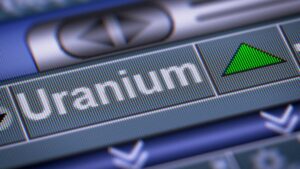Aluminium prices spiked 62pc this year – which bauxite players could be placed to benefit in 2022?

Pic: Tyler Stableford / Stone via Getty Images
In October aluminium prices spiked 62% to $2934 per tonne, up from $2004 per tonne in January and $1806 per tonne in October 2020.
This came as China began to decrease due to restrictions on energy usage – because the process of aluminium smelting is super energy intensive so not great for CO2 emissions targets.
Plus, China halted production on a 300,000-tonne capacity factory in the Yunnan province after an explosion in November which further limited its output and exacerbated the supply shortage.
Market research company IndexBox reckons this means the yearly price in 2022 will rise by 6% year-on-year.
This price growth is partly due to the high demand from the automotive industry, increased prices of energy resources as well as the supply shortage from China.
Added to this, rumours are flowing that Indonesia is contemplating a bauxite export ban.
So, what does this mean for bauxite players?
Beijing Expects Guinea Will Take Up Slack From Potential Indonesia Bauxite Export Ban https://t.co/lImso6pMAI
— Aluminium Insider (@InsideAluminium) December 6, 2021
Grade will be key to lower emissions
Canyon Resources (ASX:CAY) managing director Phillip Gallagher said there’s a disconnect in the market between bauxite and aluminium, because of the production process where bauxite is refined into alumina and then alumina is smelted into aluminium.
“As the world is going for green aluminium, it’s all about the lower energy refining,” he said.
“And the reason high grade bauxite matters is that if you put two tonnes of bauxite into your alumina refinery, and that bauxite is over 50% aluminium, then for every two tonnes you’re going to get one tonne of alumina.
“If you’ve put two tonnes of 30 or 40% bauxite in your alumina refinery, then you need three or four tonnes to get that one tonne of alumina.
“And alumina refining is a huge consumer of energy, it’s massive, it takes huge amounts of high heat so the higher the grade, the less energy input and it’s a lot cheaper to produce.
“That’s why there’s demand.”
Alcoa is still prime for the material and yes the technology is worth a fortune. Makes bauxite more valuable. Surprise, Guinea has the largest reserves followed by “Australia”. pic.twitter.com/W7sPaBybpc
— TheRand2025 (@TheRand2025) December 8, 2021
Diversifying supply away from Guinea
Currently Guinea supplies most of the world’s bauxite because it’s the only place in the world that supplies very high-grade low silica bauxite – and high grade is king.
But the country had a military coup in September which put refiners on edge and sent prices soaring to 18-month highs.
“What that means for the refiner is, that if something bad were to happen in Guinea, they might not be able to get any bauxite at all,” Gallagher said.
“And we’re the only alternative, because we have the only deposit outside of Guinea with that grade of bauxite in the world.
“I can hand on heart say as a junior mining company MD, we’ve got the highest grade in the world.
“We’ve got to billion tonnes of it.”
The company’s Minim Martap project is just next door in Cameroon, and Gallagher said the updated the BFS boasts a “game changing” 20% increase in tonnage capacity to 6 million tpa.
“It’s great because we can get more bauxite out, therefore we make more money,” he said.
“And having agreed to mining convention terms with the government, we can now move forward with funding partners and strategic partners.”
Not to mention the project is expected to be much greener than its peers because its high-grade would require less caustic soda consumption and lower red mud disposal costs while requiring less energy for processing.
Who are the other bauxite/aluminium players on the ASX?
Alumina Ltd (ASX:AWC), South32 (ASX:S32) and Rio Tino (ASX:RIO) are the bigger names in the game.
Alumina Ltd is the go-to stock on the ASX for pure play exposure to the aluminium market, as the 40% owner of the Alcoa World Alumina and Chemicals business managed by America’s Alcoa.
South32 owns the Worsley alumina business in WA, and Rio the Weipa bauxite operations in Far North Queensland.
Smaller players include Lindian Resources (ASX:LIN), which actually owns three mines in Guinea – the Woula, Gaoual and the Lelouma Project.
The company said in September that mining activities have not been impacted by political unrest in the country.
“The political situation in Guinea has not impacted the bauxite industry with mining, processing and export operations continuing as usual,” LIN said.
Then there’s Australian Bauxite (ASX:ABX) which owns the Fingal Rail bauxite mine in Tasmania.
The company also has its hands in the production pie, announcing yesterday its subsidiary Alcore had kicked off construction of a pilot plant to produce precursor chemicals required for the recovery of fluorine from ‘excess bath’, an aluminium smelter waste.
The company plans to produce aluminium fluoride (AIF3) which is an essential ingredient for aluminium smelting and is being investigated for advanced lithium-ion batteries.
Australian aluminium smelters rely entirely on imported AlF3 from China, but this proportion has reduced by more than 60% in 2021, which the company says is a supply risk.
Speaking of China, last month small bauxite miner Metro Mining (ASX:MMI) agreed to supply Xiamen Xiangsen Aluminium with ~5 Million Wet Metric Tonnes (WMT) of bauxite between 2022 and 2024 from its Queensland mine.
This is a big step up from the initial 1 million tonne from 2021-2023 deal announced in July, with the parties working on detailed binding terms and delivery details for the 2022 offtake season.
At Stockhead we tell it like it is. While Canyon is a Stockhead advertiser, it did not sponsor this article.
Related Topics
UNLOCK INSIGHTS
Discover the untold stories of emerging ASX stocks.
Daily news and expert analysis, it's free to subscribe.
By proceeding, you confirm you understand that we handle personal information in accordance with our Privacy Policy.








